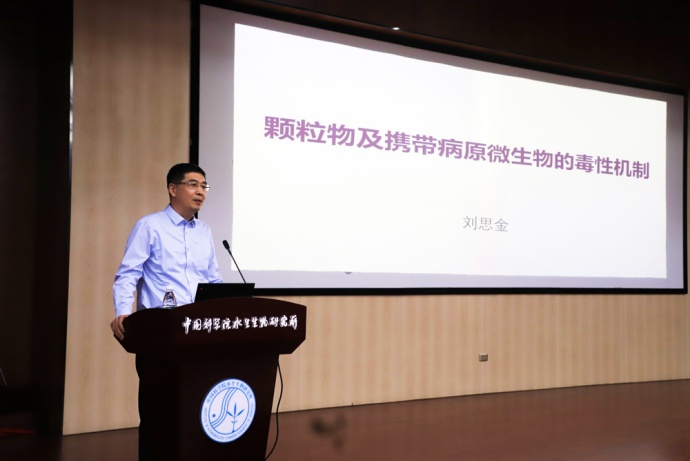
Newsroom
Professor from the Research Center for Eco-Environmental Sciences, Chinese Academy of Sciences Visits IHB
On April 24th, Prof. LIU Sijin from the Research Center for Eco-Environmental Sciences, Chinese Academy of Sciences, was invited to the Institute of Hydrobiology (IHB) of Chinese Academy of Sciences for academic exchange and delivered a lecture titled "Mechanisms of Pulmonary and Extra-Pulmonary Toxicity of Particulate Matter."
In his presentation, Prof. LIU Sijin provided an overview of the current status of air pollution worldwide and discussed how air pollution, ranking fifth in terms of threats to human mortality, far outweighs other pollutants in risk assessment. He emphasized that from 1990 to 2015, the per capita PM2.5 levels in China still exceeded national and WHO standards. Therefore, there is still a long way to go in achieving the goal of creating a beautiful China to serve a healthy China.
Based on population and experimental data, Prof. LIU Sijin's team found that naturally occurring particles observed in cerebrospinal fluid and occupational exposure particles such as CaSnSiO5 can reflect occupational exposure. Through isotope labeling simulation of lung exposure, it was discovered that inhaled air particles enter the bloodstream, thereby penetrating the joint protection system and entering the joint cavity and cartilage, explaining the phenomenon of increased orthopedic outpatient visits during smoggy and rainy days. Furthermore, through QSAR model analysis, it was found that the surface properties of particles contribute to over 60% of immune cell activation, providing a method and model for screening the immune toxicity intensity of particles. A new lactate receptor promoting pulmonary toxicity, soluble adenylate cyclase, which regulates systemic iron metabolism, was also discovered.
Additionally, Prof. LIU Sijin elaborated on the different modes of entry into the lungs between virus-carrying particles and free-state viruses under the same titer, and how the remote transfer of particles exacerbates damage to the body by viruses. The lecture sparked widespread interest among attendees, who engaged in in-depth discussions on scientific issues such as the mechanism of dynamic trans-blood-brain barrier of particulate pollutants and QSAR models.
LIU Sijin currently serves as the Party Secretary of Shandong First Medical University, a professor at the Research Center for Eco-Environmental Sciences, Chinese Academy of Sciences, a doctoral supervisor, a recipient of the National Thousand Talents Program, a national science and technology leader, a chief scientist of the National 973 Project, and a recipient of the National Distinguished Youth Foundation.
His main research areas include environmental toxicology and health research, including the molecular mechanisms of environmental pollutants on blood cell damage, environmental oncology, and the mechanism of tumor progression, as well as the biosafety of artificial nanomaterials. He has published over 230 SCI academic papers in journals such as PNAS, ACS Nano, Blood, and Nanoscale. He was awarded the Outstanding Scientific Achievement Award of the Chinese Academy of Sciences in 2013 and the Youth Scientist Award of the Chinese Academy of Sciences in 2015. He serves as the Deputy Director of the State Key Laboratory of Environmental Chemistry and Ecotoxicology, the Director of the Analysis Toxicology Professional Committee of the Chinese Society of Toxicology, and a member of the 14th National Committee of the Chinese People's Political Consultative Conference.

Professor from the Research Center for Eco-Environmental Sciences, Chinese Academy of Sciences visits IHB on April 24, 2024 (Credit: IHB)